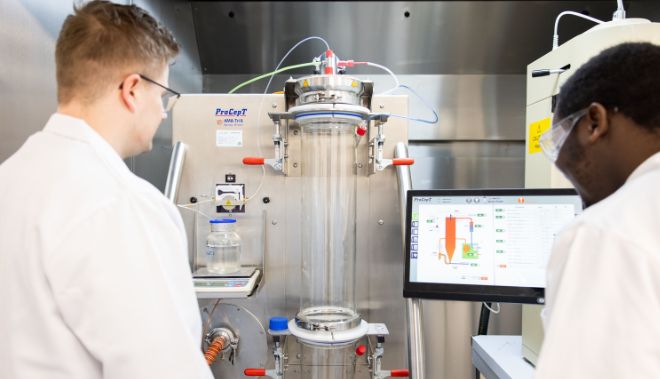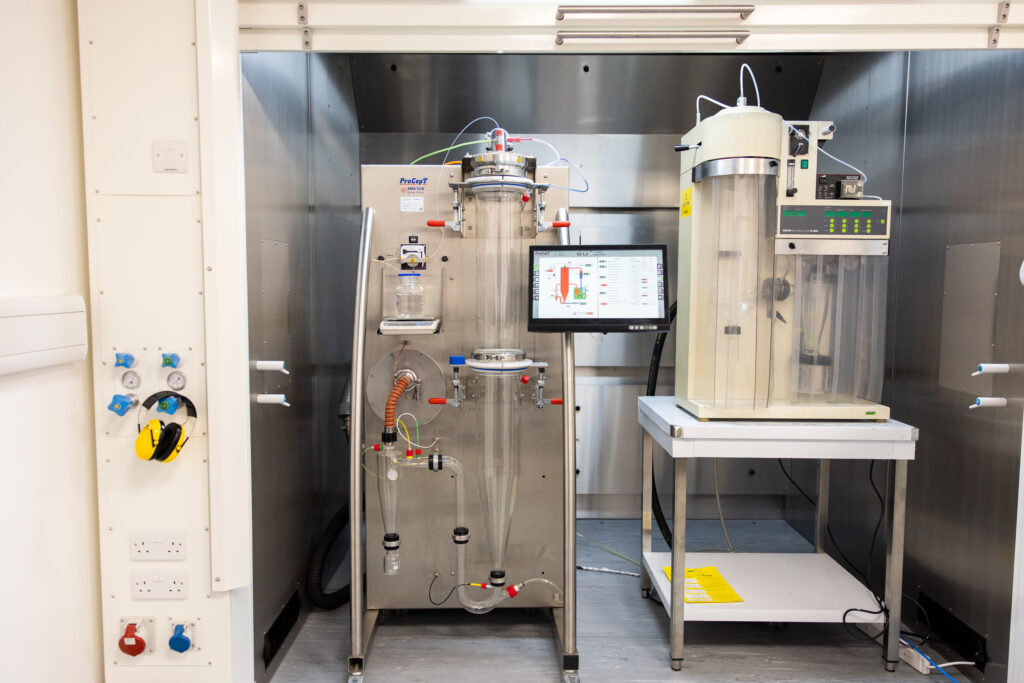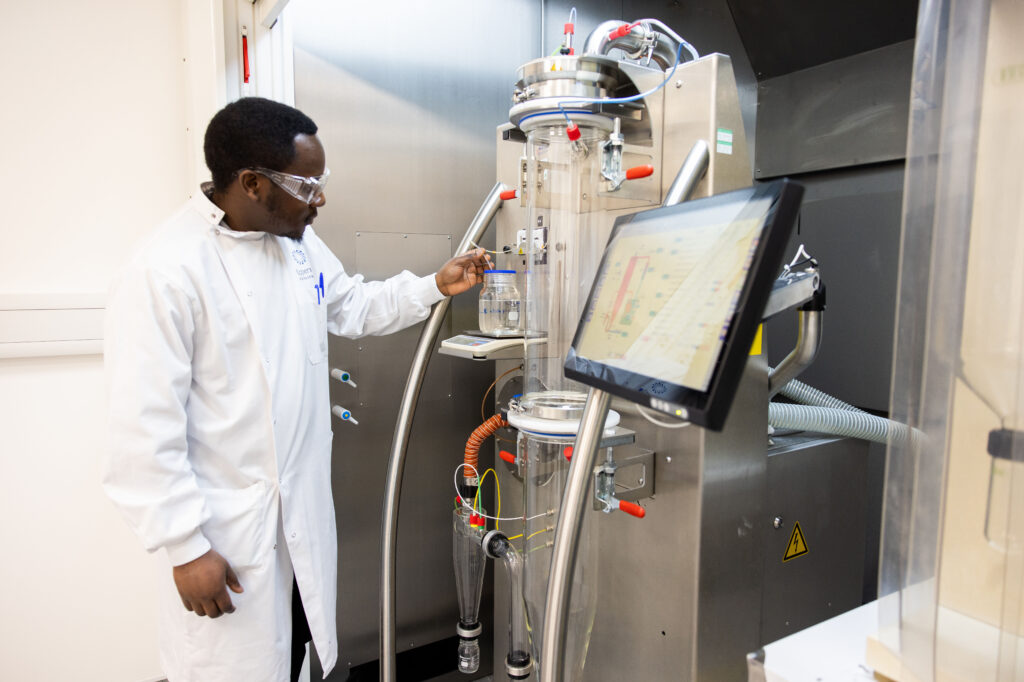An Overview of Spray Drying
Spray drying has become a core process for the development of solid dosage forms, particularly for active pharmaceutical ingredients (APIs) that have poor solubility and bioavailability. Through the creation of amorphous solid dispersions (ASDs), spray drying improves the dissolution rate and stability of APIs. This method is also critical for optimising oral solid dosage forms, such as tablets and capsules. Achieving the desired properties in the final product requires careful consideration of formulation, process parameters, and equipment.

Key Considerations for API Formulation in Spray Drying
1 – Solubility and Bioavailability Challenges
Many APIs, particularly those classified as BCS (Biopharmaceutics Classification System) Class II or IV, exhibit low solubility and, consequently, poor bioavailability. Spray drying can address these challenges by converting the API into an amorphous solid dispersion, which increases its surface area and dissolution rate. The amorphous form is typically more soluble than crystalline APIs but can be unstable, leading to crystallisation over time.
To overcome this, a stabilising polymer matrix is used, which not only enhances the solubility but also prevents crystallisation by reducing molecular mobility. Common polymers used for this purpose include polyvinylpyrrolidone (PVP), hydroxypropylmethyl cellulose (HPMC), and hypromellose acetate succinate (HPMCAS).
2 – Excipient Selection
The excipient choice is fundamental to the stability and performance of spray-dried formulations. Excipient types must be carefully selected to match the chemical properties of the API while preventing degradation. Considerations for excipient compatibility include:
- Polymer Compatibility: The polymer must be chemically compatible with the API to avoid reactions that could compromise stability.
- Solubility Modulators: Some excipients, like surfactants, are used to enhance API solubility in aqueous media. Surfactants can also aid in the stabilisation of the API, improving its dispersibility.
- Impact on crystallisation: The polymer’s role in maintaining the amorphous state of the API is crucial. The polymer matrix must be designed to prevent crystallisation, ensuring long-term stability and bioavailability.
3 – Solvent Selection and Removal
During spray drying, APIs and excipients are typically dissolved in solvents, which are then rapidly evaporated to form the dry powder. Solvent selection is a critical step because the solvent must be compatible with both the API and the excipient, and it must be easily removed during the drying process. Common solvents include acetone, methanol, and ethanol.
The solvent must dissolve the components effectively, but it should also evaporate quickly during the spray drying process to form solid particles. Additionally, residual solvent levels in the final product must comply with regulatory standards, which means proper solvent removal is essential. In some cases, post-drying techniques, such as vacuum drying, may be necessary to ensure that residual solvents do not remain in the final product.
Spray Drying Equipment and Process Parameters
Atomization and Droplet Formation
The spray drying process begins with atomization, where a liquid feed is converted into fine droplets that will then be dried. The method of atomization affects particle size, uniformity, and the surface area of the resulting powder, all of which impact the dissolution rate of the API. There are several types of atomizers used in spray drying:
- Rotary Atomizers: These create very fine droplets by rotating at high speeds. The uniformity of the droplets produced can lead to consistent particle sizes.
- Pressure Nozzle Atomizers: These produce larger droplets, which may result in slightly larger particles compared to rotary atomizers. This can be beneficial when designing formulations that require controlled particle sizes.
Each atomizer type has its benefits depending on the desired outcome in terms of particle characteristics.
Temperature and Drying Chamber Conditions
The temperature within the drying chamber plays a crucial role in the overall success of the spray drying process. Higher temperatures result in faster evaporation of the solvent, but excessive heat may cause the API or excipients to degrade, impacting the product’s stability.
An ideal drying temperature must be selected based on the API’s thermal stability and the desired drying time. Humidity control also plays a role in ensuring the stability of the product. High humidity can increase the likelihood of hygroscopic behaviour in the final powder, which is undesirable for many formulations.
To prevent API degradation, spray dryers often incorporate a controlled atmosphere with inert gases, such as nitrogen, to prevent oxidation during the drying process.


Particle Size and Distribution
One of the most significant benefits of spray drying is the ability to control the particle size and distribution. Smaller particles tend to dissolve faster, which can improve bioavailability. However, excessively small particles can lead to issues such as agglomeration or poor flow properties.
Particle size control is critical for formulations intended for OSD forms. The ideal particle size distribution will depend on the dosage form being developed. Tablets and capsules require powders that flow well and can be compressed into uniform doses.
Stability and Shelf-Life of Spray-Dried Products
Crystallisation and Metastability
Amorphous APIs, though more soluble, are inherently unstable and can crystallise over time. This crystallisation reduces the solubility and, therefore, the bioavailability of the drug. To delay crystallisation, polymers must be carefully selected to maintain the amorphous form of the API. Additionally, the processing conditions, such as temperature and drying rate, must be optimised to minimise the chances of crystallisation.
Long-term stability testing is necessary to ensure that the spray-dried product maintains its amorphous state and efficacy during its shelf life. Accelerated stability studies are commonly used to simulate long-term storage conditions and predict the product’s behaviour over time.
Moisture Sensitivity
Amorphous solids tend to be more hygroscopic than their crystalline counterparts, meaning they absorb moisture from the environment. This can lead to crystallisation or changes in the performance of the drug. The final spray-dried product should therefore be stored in moisture-resistant packaging to protect it from environmental humidity.
Some polymer excipients also help reduce the moisture sensitivity of spray-dried products. Hydrophobic excipients can act as moisture barriers, enhancing the stability of the API.
Applications in Oral Solid Dosage Forms (OSDs)
Spray drying is a versatile technique for developing a wide range of OSD formulations. From tablets to capsules, spray-dried powders can be processed further to create stable, high-performance drug products. In particular, spray drying is beneficial for poorly soluble APIs, which are increasingly common in modern drug development.
Bioavailability Enhancement
For poorly soluble APIs, spray drying improves bioavailability by creating a more soluble amorphous form that dissolves quickly in the body. By incorporating the API into an ASD, its solubility and dissolution rate are enhanced, leading to better absorption in the gastrointestinal tract.
Controlled Release and Targeted Delivery
Spray-dried dispersions can be engineered to modify drug release profiles, including controlled release or targeted delivery. This is particularly useful for drugs that require sustained release over time. By adjusting the formulation of the spray-dried powder, it is possible to design products that release the API in a controlled manner, improving therapeutic outcomes.
Powder Flowability and Compaction
Spray drying produces powders with good flowability, making them easier to handle in downstream processing such as tableting and encapsulation. The uniformity of the particles also ensures that each tablet or capsule contains the correct dose of the API, enhancing product consistency.
Conclusion
Spray drying is a powerful technique in the development of pharmaceutical formulations, especially for APIs with poor solubility and bioavailability. By carefully selecting excipients, optimising process parameters, and controlling particle size, manufacturers can create stable, high-performance solid dosage forms. Spray drying not only enhances the solubility of challenging APIs but also allows for the customization of release profiles in OSD forms. When used correctly, this method can significantly improve the therapeutic efficacy and patient adherence of drug products.
Let's work together
How can we help you?
Frequently Asked Questions
What is Pharmaceutical Spray Drying?
Spray drying is a process that transforms a liquid solution or suspension containing APIs and excipients into a dry powder by rapidly evaporating the solvent using a hot gas. This method is widely used to produce dry powders for various pharmaceutical applications, including the creation of amorphous solid dispersions to improve drug solubility and bioavailability.
How does spray drying enhance the solubility of poorly soluble APIs?
Spray drying converts crystalline APIs into an amorphous form, which typically exhibits higher solubility. By dispersing the API in a polymer matrix during the spray drying process, the resulting amorphous solid dispersion increases the surface area and dissolution rate of the drug, thereby enhancing its bioavailability.
What factors should be considered when selecting excipients for spray-dried formulations?
Key considerations include:
- Polymer Compatibility: The chosen polymer should be chemically compatible with the API to prevent adverse reactions that could affect stability.
- Solubility Enhancement: Excipients like surfactants can improve API solubility in aqueous media and aid in stabilization.
- Crystallization Inhibition: The polymer should maintain the API in its amorphous state to ensure long-term stability and bioavailability.
Commonly used polymers include polyvinylpyrrolidone (PVP) and hydroxypropylmethyl cellulose (HPMC).
What are the critical process parameters in spray drying for pharmaceuticals?
Important parameters include:
- Atomization Method: Determines droplet size and uniformity, affecting particle size and dissolution rate.
- Drying Temperature: Must be optimized to ensure rapid solvent evaporation without degrading the API or excipients.
- Solvent Selection and Removal: The solvent should effectively dissolve the components and be easily removable to meet regulatory standards for residual solvents.
What are the advantages of spray drying over other drying methods in pharmaceutical manufacturing?
Spray drying offers several benefits, including:
- Rapid Drying: Quick solvent evaporation minimizes thermal degradation of heat-sensitive APIs.
- Particle Size Control: Ability to produce particles with specific sizes and distributions, essential for consistent dosing.
- Enhanced Bioavailability: Improves solubility of poorly soluble drugs through the formation of amorphous solid dispersions.
- Scalability: Suitable for both laboratory-scale and large-scale production.